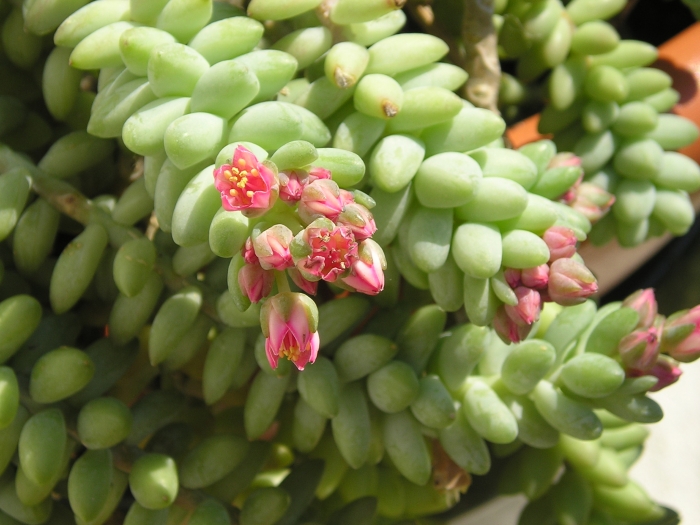Baby Burro’s Tail
(Sedum burrito)
Baby Burro’s Tail (Sedum burrito)
/
/

Morningdew51 Wikipedia
CC BY-SA 3.0
Image By:
Morningdew51 Wikipedia
Recorded By:
Copyright:
CC BY-SA 3.0
Copyright Notice:
Photo by: Morningdew51 Wikipedia | License Type: CC BY-SA 3.0 | License URL: http://creativecommons.org/licenses/by-sa/3.0/ | Uploader: Webaware | Publisher: Wikimedia Commons | Title: Donkey's_tail_in_bloom_March_06.jpg | Notes: |
















Estimated Native Range
Summary
Sedum burrito, commonly known as Baby Burro’s Tail, is an evergreen succulent native to the arid climates of Mexico, where it thrives on rocky outcrops. This plant typically grows to a height of 0.9 feet (0.3 meters) and a width of 2 feet (0.6 meters), with trailing stems that can reach several feet in length if given the space. The stems are densely packed with fleshy, blue-green leaves that have a distinctive, waxy coating to reduce water loss. During the summer, it produces small, pink to red flowers that add a splash of color to its cascading foliage.
Baby Burro’s Tail is valued for its unique trailing habit and ease of care, making it a popular choice for hanging baskets and as a houseplant. It is also used in rock gardens and as ground cover in xeriscaping. In cultivation, it prefers bright, indirect light or partial shade and requires well-draining soil to prevent root rot. Watering should be moderate throughout the growing season and reduced in winter. While it can tolerate full sun, too much direct sunlight can scorch the leaves. It is susceptible to overwatering and should be monitored for signs of rot. Propagation is easily achieved through stem or leaf cuttings, which readily root in favorable conditions.CC BY-SA 4.0
Baby Burro’s Tail is valued for its unique trailing habit and ease of care, making it a popular choice for hanging baskets and as a houseplant. It is also used in rock gardens and as ground cover in xeriscaping. In cultivation, it prefers bright, indirect light or partial shade and requires well-draining soil to prevent root rot. Watering should be moderate throughout the growing season and reduced in winter. While it can tolerate full sun, too much direct sunlight can scorch the leaves. It is susceptible to overwatering and should be monitored for signs of rot. Propagation is easily achieved through stem or leaf cuttings, which readily root in favorable conditions.CC BY-SA 4.0
Plant Description
- Plant Type: Succulent
- Height: 0.7-0.9 feet
- Width: 1-1.5 feet
- Growth Rate: Slow
- Flower Color: Pink
- Flowering Season: Summer
- Leaf Retention: Evergreen
Growth Requirements
- Sun: Part Shade
- Water: Very Low, Low
- Drainage: Fast
Common Uses
Deer Resistant, Drought Tolerant, Fire Resistant, Groundcover, Low Maintenance, Potted Plant, Rock Garden, Street Planting
Natural Habitat
native to the arid climates of Mexico, where it thrives on rocky outcrops
Other Names
Common Names: Donkey Tail, Burro’s Tail, Baby Donkey’s Tail
Scientific Names: , Sedum burrito,
GBIF Accepted Name: Sedum burrito Moran